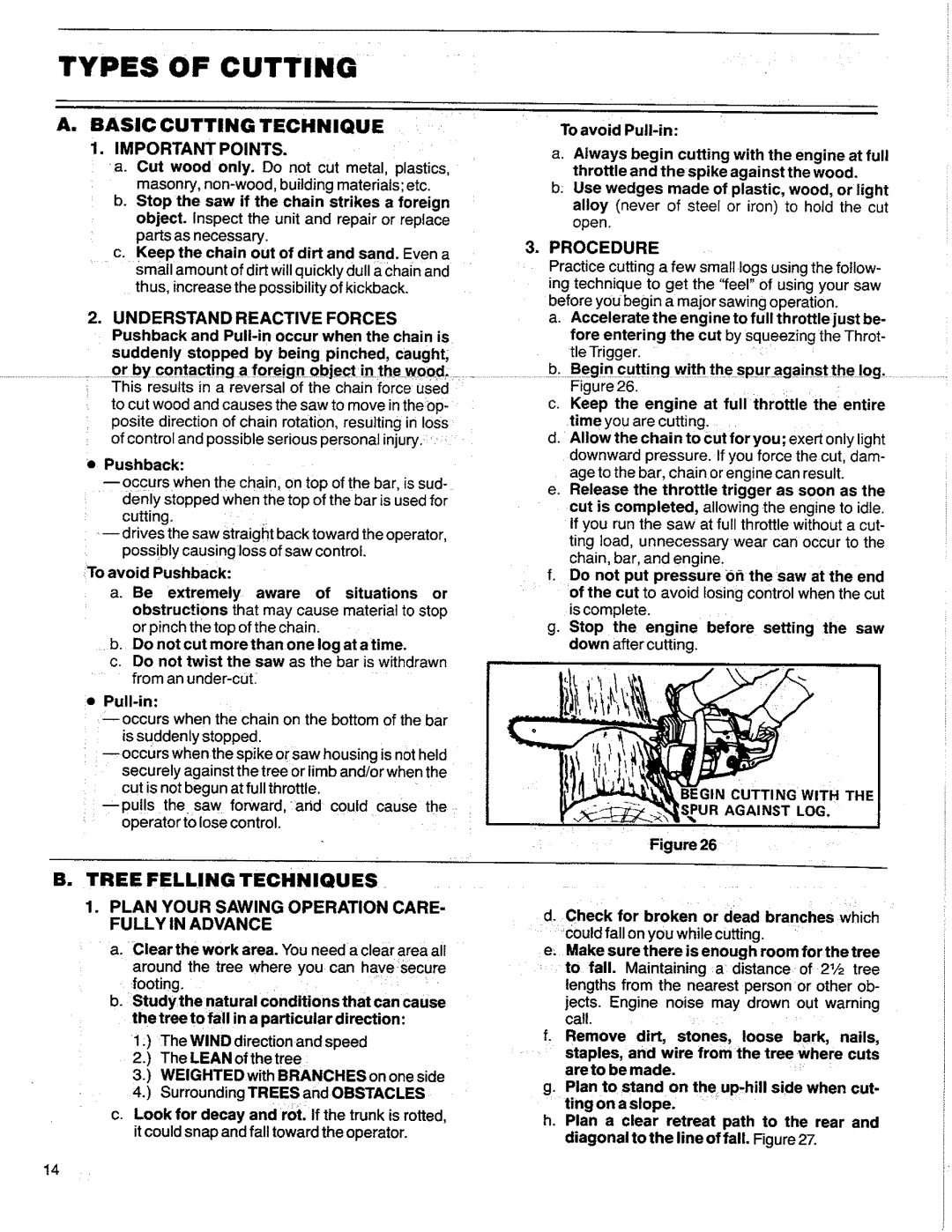
TYPES OF CUTTING .....
Ae BASIC CUTTING TECHNIQUE
1. IMPORTANT POINTS.
•a. Cut wood only. Do not cut metal, plastics, masonry,
b. Stop the saw if the chain strikes a foreign object. Inspect the unit and repair or replace parts as necessary.
c.Keep the chain out of dirt and sand. Even a
To avoid
a. Always begin cutting with the engine at full throttle and the spike against the wood.
b:Use wedges made of plastic, wood, or light alloy (never of steel or iron) to hold the cut open.
mPROCEDURE
small amount | of dirt will quickly dull a Chain and | Practice cutting a few smalt logs using the follow- | |||||
thus, increase the possibility | of kickback. | ing technique | to get the '_eel" of using your | saw | |||
2. UNDERSTAND | REACTIVE | FORCES | before you begin a major sawing operation. |
| |||
a. Accelerate | the engine to full throttle | just | be- | ||||
Pushback | and | fore entering the cut by squeezing | the Throt- | ||||
suddenly | stopped by being | pinched, caught, | tleTrigger. |
|
|
| |
...........................................o r by #ontactinga, fore!gn.obje_ in_the_wood__...........................),....Begin cutting with the spur against the log.
This results in a reversal of the chain force | used |
| Figure 26, |
|
|
| |||||||||
to cut wood and causes | the saw to move in the op- | c. | Keep | the engine | at full | throttle | the entire | ||||||||
posite | direction | of | chain | rotation, | resulting in loss |
| time you are cutting. |
|
|
| |||||
of control and possible serious | personal injury.:'. | d. | Allow the chain to Cut foryou; exert only light | ||||||||||||
'e Pushback: |
|
|
|
|
|
|
| downward pressure. If you force the cut, dam- | |||||||
|
|
|
|
|
|
| age to the bar, chain or eng_ne can result. | ||||||||
when the chain | on top of the bar, is sud- |
| |||||||||||||
e. Release the throttle trigger as soon as the | |||||||||||||||
| deftly stopped When the top of the bar is used for | ||||||||||||||
|
| cut is completed, allowing the engine to idle. | |||||||||||||
| cutting. |
|
|
|
|
|
|
| |||||||
|
|
|
|
|
|
|
| If you run the saw at full throttle without a cut- | |||||||
.... drives the saw straigl_t back toward the operator, |
| ||||||||||||||
| ting load, unnecessary wear can occur to the | ||||||||||||||
| poss!bly causingloss of saw control. |
|
| ||||||||||||
|
|
| chain, bar, and engine. |
|
| ||||||||||
To avoid Pushback: |
|
|
|
|
|
|
|
| |||||||
|
|
|
|
| f. | Do not put pressure oh the saw | at the end | ||||||||
|
|
|
|
|
|
|
|
| |||||||
a. | Be | extremely | aware | of | situations | or |
| of the cut to avoid Iosing control when the cut | |||||||
| obstructions | that may cause material to stop |
| iscomplete. |
|
|
| ||||||||
| or pinch the top of the chain. |
|
| g. | Stop | the engine | before | setting | the saw | ||||||
....b. | Do not cut more than one log at a time. |
|
| down after cutting. |
|
|
| ||||||||
c.Do not twist the saw as the bar is withdrawn =" from an
e
R occurs when the chain on the bottom of the bar
is suddenly stopped.
--occurs when the spike orsaw housing is not held securely against the tree or limb and/or when the cut is not begun at full throttle.
=• •:
BEGIN CUTTING WITH THE PUR AGAINST LOG.
Figure 26
B. TREE FELLING TECHNIQUES ....
. PLAN YOUR SAWING OPERATION CARE- FULLY IN ADVANCE
a. Clear the work area. You needa clear area all around the tree where you can have:secure
footing.•'=:_
b. Studythe natural conditions that can cause thetree to fall in a particular direction:
1 :) The WIND direction and speed
2.) The LEAN of thetree :
3.) WEIGHTED with BRANCHESon one side
4.) Surrounding TREES and OBSTACLES
c.Look for decay and r0t. If the trunk is rotted, itcould snap and fall toward the operator.
d. Check for broken or dead branches which Could fall on you while cutting.
e:Make sure there is enough room for the tree to fall. Maintaining a distance of 21/2 tree lengths from the nearest person or other ob-
jects. Engine noise may drown out warning carl.
f. Remove dirt, stones, loose bark, nails,
staples, and wire from the tree =where cuts are to be made.
g.Plan to stand on the
h.Plan a clear retreat path to the rear and diagonal to the line of fall. Figure27.
14
